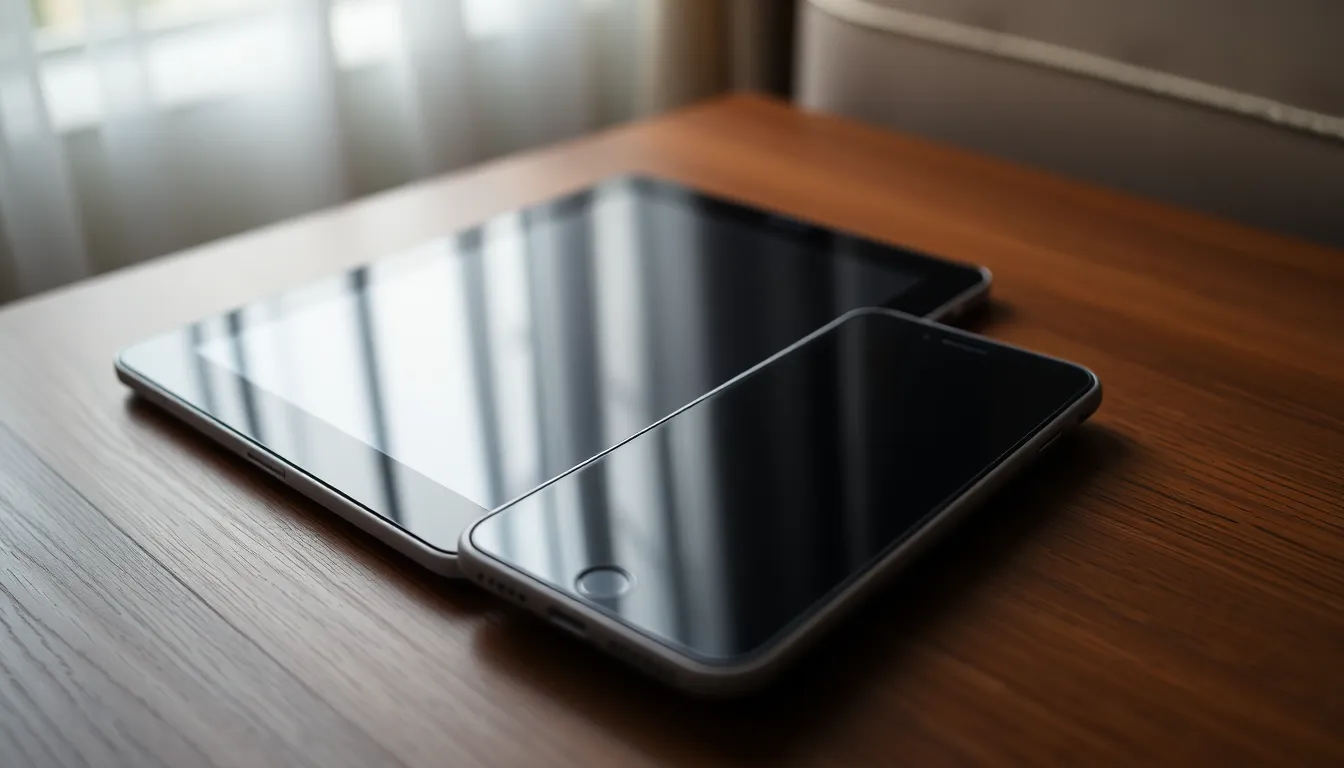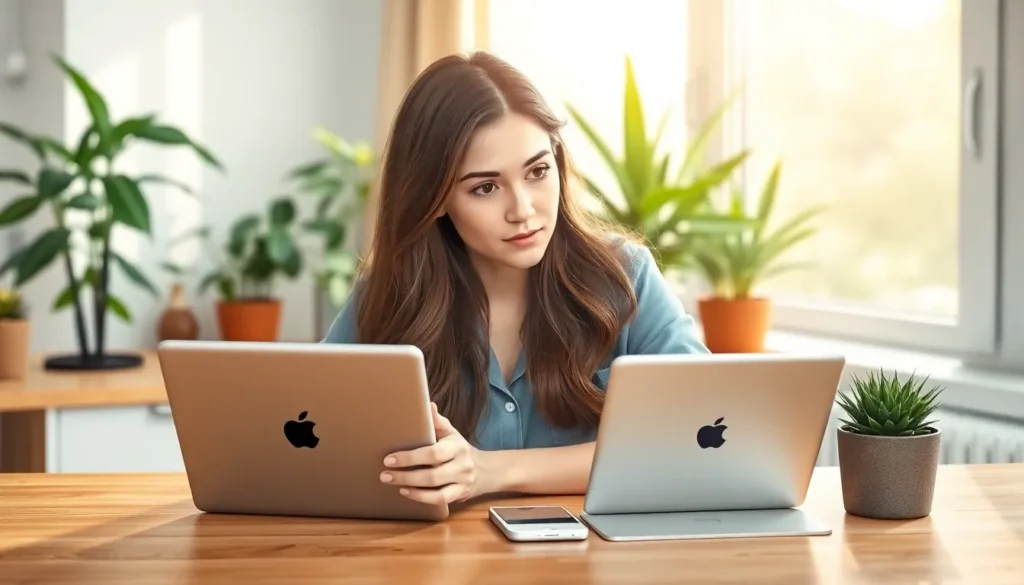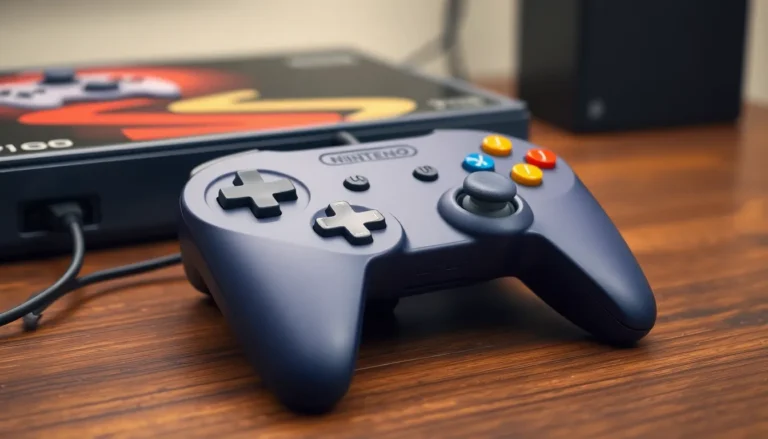In a world where devices are practically glued to our fingertips, sometimes it’s time to cut the cord—at least digitally. If your iPad and iPhone have been joined at the hip, sharing everything from messages to apps, you might feel like you’re in a techy relationship that’s just a bit too close for comfort. Whether you’re tired of accidental messages popping up on both screens or simply want some personal space, unlinking these devices is a breeze.
Table of Contents
ToggleUnderstanding Device Linkage
Linking an iPad and iPhone allows users to share functionalities and content seamlessly. It involves connecting devices through Apple ID, enabling shared services like iMessages and app purchases.
What It Means to Link Devices
Linking devices means creating a digital connection between an iPad and an iPhone. This connection allows for simultaneous notifications and synced data across both devices. Owners receive messages on either device, simplifying communication. Linking also makes it easier to share app access, ensuring both devices stay updated with the same information. Users can enjoy one unified account, enhancing overall convenience in their digital routine.
Benefits of Linking iPad and iPhone
Linking iPad and iPhone offers several advantages that enhance user experience. Users can easily transfer files and data between devices without manual synchronization. Notifications appear on both devices, keeping individuals constantly informed. Users benefit from app purchases made on one device becoming accessible on the other. The linked devices support seamless continuity, allowing users to start tasks on one device and finish them on the other. This integration significantly streamlines daily activities, thereby maximizing productivity.
Reasons to Unlink iPad from iPhone

Unlinking an iPad from an iPhone can address several key issues that arise from their close integration. Understanding these reasons helps users make informed decisions.
Privacy Concerns
Privacy concerns often arise when devices are interconnected. Linked devices may share sensitive information such as messages, location data, and app usage. Unlinking these devices reduces the risk of unauthorized access to personal content. It allows individuals to maintain distinct identities for their devices, minimizing unwanted notifications and communications. Implementing separate profiles ensures that private information remains confidential, allowing for a more secure user experience.
Device Management
Effective device management can be hindered by tight integration between an iPad and iPhone. Users may face challenges when trying to manage apps and settings across linked devices. Unlinking these devices simplifies this process, enabling customization of features and notification preferences on each device independently. Individual control helps optimize performance, leading to more efficient use of resources. Additionally, targeted management allows tailored software updates and app installations, ensuring each device runs smoothly without interference from the other.
How to Unlink iPad from iPhone
Users may choose to unlink an iPad from an iPhone for various reasons, including privacy concerns and independent device management. The following methods provide simple steps to achieve this.
Method 1: Using Settings
Open the Settings app on the iPad. Tap on your name at the top of the screen to access Apple ID settings. Scroll down to find the “Find My” option. Disable it if it is enabled. Next, tap “iCloud” and sign out by scrolling to the bottom. Confirm the action by selecting “Sign Out.” This process separates the devices, ensuring they won’t share data or notifications.
Method 2: Using Apple ID
Access the Apple ID page through a web browser or the Settings app on either device. Sign in with your Apple ID credentials. Once logged in, navigate to the “Devices” section. Locate the iPad within the list and select it. Choose the option to remove the device. This action effectively removes the iPad from the linked Apple ID, unlinking it from the iPhone.
Post-Unlinking Considerations
Unlinking an iPad from an iPhone opens new avenues for managing each device independently. Users gain better control over notifications and app settings, tailoring their experience according to their preferences.
Managing Your Devices
Effective device management becomes easier after unlinking. Maintaining distinct settings for each device allows for personalized adjustments without interference. Users can allocate specific notifications to their iPad and iPhone, ensuring more focused attention. Furthermore, managing apps independently streamlines updates and organization, catering to individual needs. Customizing features and functions can enhance performance significantly. Daily tasks become more efficient, as users navigate their devices in a way that suits their lifestyle.
Re-Linking When Necessary
Re-linking devices may become essential if users desire coordinated functionality or shared data again. Linking the iPad back to an iPhone is straightforward, involving simple steps through the Settings app or the Apple ID page. Users can easily reconnect to sync contacts, calendar events, and shared applications when necessary. Ensuring both devices serve users’ needs becomes achievable through this process. When both devices are linked, users experience enhanced convenience, but maintaining the option to unlink as needed offers flexibility.
Unlinking an iPad from an iPhone offers users the chance to reclaim their digital space and enhance their privacy. By following the practical methods outlined, individuals can effectively separate their devices and enjoy a more personalized experience. This process not only streamlines device management but also allows for tailored notifications and settings that cater to individual preferences.
The ability to unlink and re-link devices as needed provides flexibility in managing technology. Users can adapt their approach based on their lifestyle while ensuring each device operates independently. Embracing this control can lead to a more organized and efficient daily routine.









